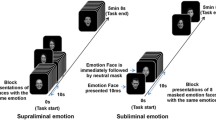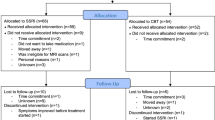Abstract
Rationale
We have previously demonstrated that antidepressant medication facilitates the processing of positive affective stimuli in healthy volunteers. These early effects of antidepressants may be an important component in the therapeutic effects of antidepressant treatment in patients with depression and anxiety.
Objectives
Here we used functional magnetic resonance imaging in a double-blind, randomised, placebo-controlled between-groups design to investigate the effects of short-term (7–10 days) treatment with the selective serotonin reuptake inhibitor, citalopram, on the amygdala response to positive and negative facial expressions in healthy volunteers.
Results
Citalopram was associated with increased amygdala activation to happy faces relative to placebo control, without changes in levels of mood or anxiety.
Conclusions
These early, direct effects of antidepressant administration on emotional processing are consistent with a cognitive neuropsychological model of antidepressant action.



Similar content being viewed by others
References
Arce E, Simmons AN, Lovero KL, Stein MB, Paulus MP (2008) Escitalopram effects on insula and amygdala BOLD activation during emotional processing. Psychopharmacology (Berl) 196:661–672
Artigas F, Nutt DJ, Shelton R (2002) Mechanism of action of antidepressants. Psychopharmacol Bull 36(Suppl 2):123–132
Beck AT, Ward CH, Mendelson M, Mock J, Erbaugh J (1961) An inventory for measuring depression. Arch Gen Psychiatry 4:561–571
Canli T, Sivers H, Whitfield SL, Gotlib IH, Gabrieli JD (2002) Amygdala response to happy faces as a function of extraversion. Science 296:2191
Costafreda SG, Brammer MJ, David AS, Fu CH, Sergerie K, Chochol C, Armony JL (2007) Predictors of amygdala activation during the processing of emotional stimuli: a meta-analysis of 385 PET and fMRI studies. Brain Res Rev 12:12
Drevets WC (2003) Neuroimaging abnormalities in the amygdala in mood disorders. Ann NY Acad Sci 985:420–444
Etkin A, Klemenhagen KC, Dudman JT, Rogan MT, Hen R, Kandel ER, Hirsch J (2004) Individual differences in trait anxiety predict the response of the basolateral amygdala to unconsciously processed fearful faces. Neuron 44:1043–1055
Fitzgerald DA, Angstadt M, Jelsone LM, Nathan PJ, Phan KL (2006) Beyond threat: amygdala reactivity across multiple expressions of facial affect. Neuroimage 30:1441–1448
Fu CH, Williams SC, Cleare AJ, Brammer MJ, Walsh ND, Kim J, Andrew CM, Pich EM, Williams PM, Reed LJ, Mitterschiffthaler MT, Suckling J, Bullmore ET (2004) Attenuation of the neural response to sad faces in major depression by antidepressant treatment: a prospective, event-related functional magnetic resonance imaging study. Arch Gen Psychiatry 61:877–889
Fu CH, Williams SC, Brammer MJ, Suckling J, Kim J, Cleare AJ, Walsh ND, Mitterschiffthaler MT, Andrew CM, Pich EM, Bullmore ET (2007) Neural responses to happy facial expressions in major depression following antidepressant treatment. Am J Psychiatr 164:599–607
Hariri AR, Drabant EM, Munoz KE, Kolachana BS, Mattay VS, Egan MF, Weinberger DR (2005) A susceptibility gene for affective disorders and the response of the human amygdala. Arch Gen Psychiatry 62:146–152
Harmer CJ (2008) Serotonin and emotional processing: does it help explain antidepressant drug action? Neuropharmacology 55(6):1023–1028
Harmer CJ, Shelley NC, Cowen PJ, Goodwin GM (2004) Increased positive versus negative affective perception and memory in healthy volunteers following selective serotonin and norepinephrine reuptake inhibition. Am J Psychiatr 161:1256–1263
Harmer CJ, Mackay CE, Reid CB, Cowen PJ, Goodwin GM (2006) Antidepressant drug treatment modifies the neural processing of nonconscious threat cues. Biol Psychiatry 59:816–820
Jenkinson M, Smith S (2001) A global optimisation method for robust affine registration of brain images. Med Image Anal 5:143–156
Jenkinson M, Bannister P, Brady M, Smith S (2002) Improved optimization for the robust and accurate linear registration and motion correction of brain images. Neuroimage 17:825–841
Matsumoto J, Eckman P (1988) Japanese and Caucasian Facial Expressions of Emotion (JACFEE) and Neutral Faces (JACNeuF). Human Interaction Laboratory, San Francisco
Mogg K, Garner M, Bradley BP (2007) Anxiety and orienting of gaze to angry and fearful faces. Biol Psychiatry 76:163–169
Nelson HE (1991) National Adult Reading Test, 2nd edn. NFER-Nelson
Norbury R, Mackay CE, Cowen PJ, Goodwin GM, Harmer CJ (2007) Short-term antidepressant treatment and facial processing. Functional magnetic resonance imaging study. Br J Psychiatry 190:531–532
Norbury R, Mackay CE, Cowen PJ, Goodwin GM, Harmer CJ (2008) The effects of reboxetine on emotional processing in healthy volunteers: an fMRI study. Mol Psychiatry 13:1011–1020
Patenaude B, Smith S, Kennedy D, Jenkinson M (2008) Bayesian shape and appearance models. http://www.fmrib.ox.ac.uk/analysis/techrep/tr07bp1/tr07bp1.pdf
Sander K, Frome Y, Scheich H (2007) FMRI activations of amygdala, cingulate cortex, and auditory cortex by infant laughing and crying. Hum Brain Mapp 28:1007–1022
Schaefer HS, Putnam KM, Benca RM, Davidson RJ (2006) Event-related functional magnetic resonance imaging measures of neural activity to positive social stimuli in pre- and post-treatment depression. Biol Psychiatry 60:974–986
Sheline YI, Barch DM, Donnelly JM, Ollinger JM, Snyder AZ, Mintun MA (2001) Increased amygdala response to masked emotional faces in depressed subjects resolves with antidepressant treatment: an fMRI study. Biol Psychiatry 50:651–658
Smith S (2002) Fast robust automated brain extraction. Hum Brain Mapp 17:143–155
Smith S, Jenkinson M, Woolrich MW, Beckman CF, Behrens TEJ, Johansen-Berg H, Bannister PR, De Luca M, Drobnjak I, Flitney D, Niazy N, Saunders J, Vickers J, Zhang Y, De Stefano N, Brady M, Mathews PM (2004) Advances in functional and structural MR image analysis and implementation as FSL. Neuroimage 23:S208–S219
Spielberger CD, Gorusch RL, Lushene RD (1970) STAI Manual. Consulting Psychologists Press, Washington DC
Spitzer RL, Williams JBW, Gibbon M, First MB (1995) Structured Clinical Interview for the DSM-IV (SCID-I/P), Version II. American Psychiatric Press, Arlington
Taylor MJ, Freemantle N, Geddes JR, Bhagwagar Z (2006) Early onset of selective serotonin reuptake inhibitor antidepressant action: systematic review and meta-analysis. Arch Gen Psychiatry 63:1217–1223
Tse WS, Bond AJ (2003) Reboxetine promotes social bonding in healthy volunteers. J Psychopharmacol 17:189–195
Whalen PJ, Shin LM, McInerney SC, Fischer H, Wright CI, Rauch SL (2001) A functional MRI study of human amygdala responses to facial expressions of fear versus anger. Emotion 1:70–83
Woolrich MW, Ripley BD, Brady M, Smith SM (2001) Temporal autocorrelation in univariate linear modeling of FMRI data. Neuroimage 14:1370–1386
Woolrich MW, Behrens TE, Beckmann CF, Jenkinson M, Smith SM (2004) Multilevel linear modelling for FMRI group analysis using Bayesian inference. Neuroimage 21:1732–1747
Author information
Authors and Affiliations
Corresponding author
Electronic supplementary material
Below is the link to the electronic supplementary material.
Supplementary Fig. 1
(DOC 65 kb)
Rights and permissions
About this article
Cite this article
Norbury, R., Taylor, M.J., Selvaraj, S. et al. Short-term antidepressant treatment modulates amygdala response to happy faces. Psychopharmacology 206, 197–204 (2009). https://doi.org/10.1007/s00213-009-1597-1
Received:
Accepted:
Published:
Issue Date:
DOI: https://doi.org/10.1007/s00213-009-1597-1




